Apple Maps vs. Google Maps: Which is better in 2026?
Looking for the best app to guide you wherever you need to go? Check out this in-depth Apple Maps vs. Google Maps comparison to find the one that suits you best.
Not that long ago, Apple Maps vs. Google Maps sounded like a David vs. Goliath comparison. For years, Google seemed to be miles ahead of any other map app, but the competition has been catching up, and Apple Maps has a case for being just as good, if not better, in 2026.
In this post, we’ll be taking an in-depth look at what each app has to offer and how they compare against each other in eight essential categories to determine who’s the king of map apps today.


 +1M
+1M
With Holafly, you save +30% compared to roaming fees
Plans that may interest you
1. Navigation
Navigation is arguably the most important feature of any map app, so it’s no surprise that both Google Maps and Apple Maps have got their navigation dialed to near perfection. Both tend to offer identical suggested routes, which only tend to differ if there are multiple routes with the same estimated ETA (Estimated Time of Arrival).
Both also offer alternative routes, although these tend to vary quite a lot. Google keeps updating its route calculations to consider fuel usage as well as distance and time, which can lead to some quite interesting alternative route suggestions.
Neither one is limited to calculating car routes. Both can give detailed routes and ETAs for traveling on foot, by bicycle, or by public transport. Both also take live traffic data into account and update your route on the go if traffic conditions suddenly change.
The only notable difference is that Google Maps allows you to add multiple stops to your journey and plan your road trip in advance. Apple Maps lets you add pit stops after you start your journey, but these are usually stops for gas or food. This minimal difference gives Google the slightest of advantages in this category.
Winner: Google Maps
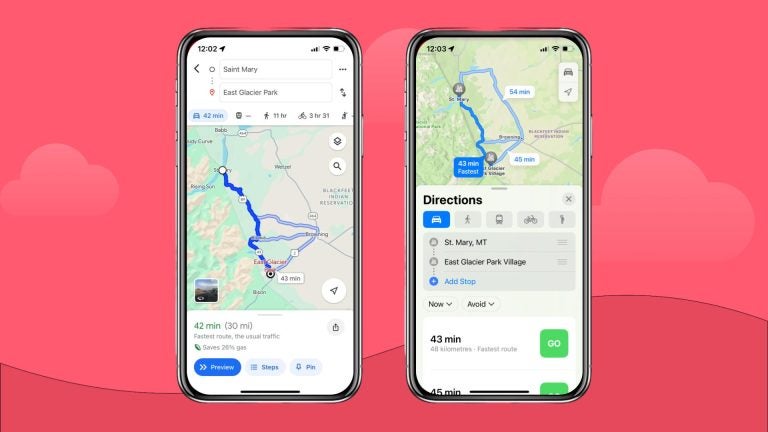
2. Interface
Comparing user interfaces is tough, as it always includes some subjectivity. Everyone has unique preferences and things they like, which means the same design can be viewed completely differently by different users.
That said, there’s no denying that the interfaces of Google Maps and Apple Maps are quite different.
Apple Maps keeps it fairly simple, with all features and buttons located on the bottom third of your phone screen. This makes the app easy to use and navigate but also means that a third of your screen is always occupied.
Google Maps has a search bar at the top, with various buttons and features spread out across the screen. This leaves more room for the map itself but means that you’ll have to do some serious finger acrobatics to tap buttons, especially considering how large the screens are on most modern smartphones.
As far as this comparison goes, Apple nudges the interface section thanks to its simple, easy-to-use design.
Winner: Apple Maps
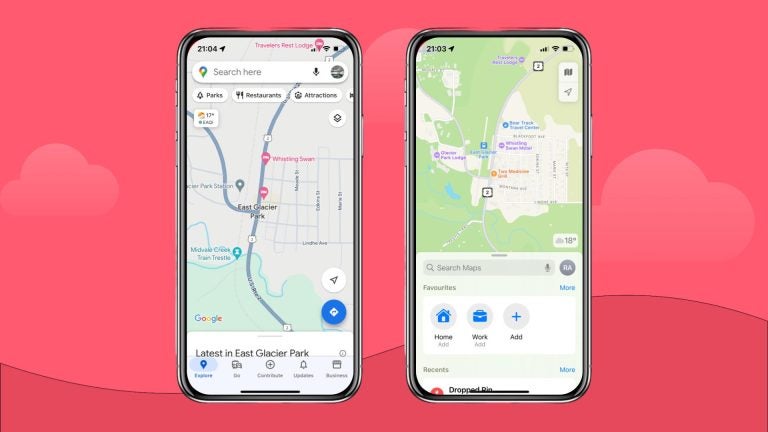
3. Privacy
Google owns the largest search engine in the world and makes billions of dollars in advertising revenue. It uses your travel data to optimize your searches and show targeted ads. This means your data travels straight to Google servers, where it’s stored to optimize your user experience with other Google services.
Google does offer an Incognito mode for Maps, which limits the amount of data Google saves, but it still requires your data to pass through Google servers.
On the other hand, Apple has shown a clear focus on improving data privacy with its maps app. It offers a feature called “fuzzing” which converts your location to a more general area 24 hours after a search.
Apple also sends your route and other data from the app via multiple unique requests, which makes your trip much harder for any cybercriminals to track. On top of that, Apple doesn’t store your search or trip data at all, making it a much better option when it comes to privacy.
Winner: Apple Maps
4. Street view
While street view isn’t an essential feature for getting from point A to point B, it comes in handy when you need help finding a specific building or business once you’re there. Google pioneered this feature, with Google’s Street View debuting in 2007, while Apple’s Look Around feature only came around in 2019.
This means that Google Maps Street View has 12 more years of data than Look Around. So, while both features function and feel very similar, Street View is available in many more locations. Look Around is fairly widespread in major cities, especially those in the USA, but lacks coverage in less populated areas.
Winner: Google Maps
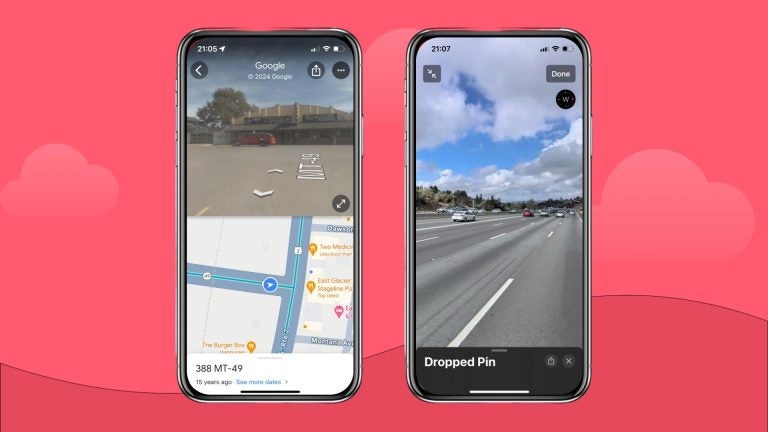
5. Data usage
From loading the map to getting traffic details and making route adjustments — it all takes data. Map apps use the internet to provide you with a good user experience and stop you from getting lost, but they’ll also use a significant amount of data while doing so.
Both apps allow you to download offline maps, so if you’re very conscious about your data usage when traveling, you can download offline maps on your home WiFi. Just make sure to download them for all regions you plan to visit.
How much data do Google Maps use?
The data Google Maps uses depends on how you use it. Basic turn-by-turn directions use 5-10 MB of data an hour, but things like loading maps of different locations, changing view modes, or checking business or restaurant reviews also uses data. Depending on how you use Google Maps, it can add up to 200 MB or more a day.
How much data do Apple Maps use?
The amount of data Apple Maps uses is similar to that of Google Maps. You can expect to use 5-10 MB for regular driving, but if you explore satellite maps, use 3D maps, or keep looking at locations through Look Around, the data usage is bound to increase.
Winner: Draw
6. Discovery
Whether you’re looking for things to do or places to visit, checking them on maps has become the go to option for doing so. It’s super convenient since you can find essential information and reviews, and the directions to visit the place you’re looking at are one click away.
When it comes to the Google Maps vs. Apple Maps comparison, Google has a clear edge because it can link Maps to its search engine, which makes it easy to provide any information the user may look for.
Menus, reviews, working hours, websites, prices, and much more can be found just by checking out a place on Google Maps.
Apple does its best to keep up by partnering with Tripadvisor and Yelp, which provide similar information as well. That said, Google takes the cake thanks to how easy it is to find places. With one tap of the screen, you can get a list of all gas stations, restaurants, ATMs, and hotels in the area.
So, while Apple’s discovery solutions work well, Google simply makes it effortless.
Winner: Google Maps
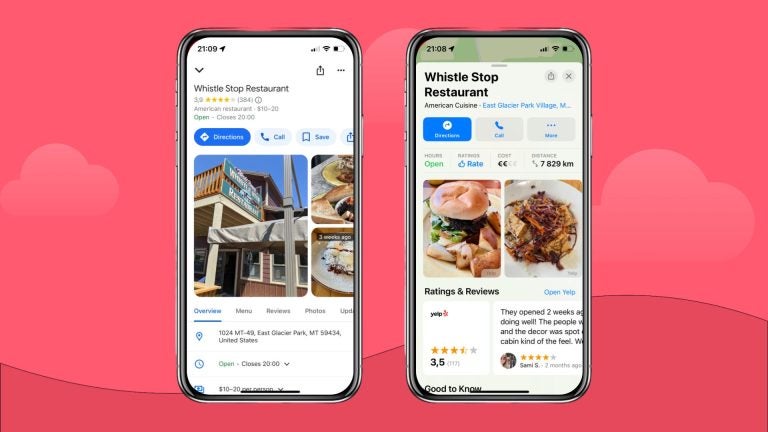
7. Live traffic data
Both Google Maps and Apple Maps show real-time traffic data and adjust routes accordingly to avoid traffic jams and complete your journey as fast as possible. Both also allow users to report issues such as car accidents or speed cameras.
Of course, this requires user input, and Google Maps has more users as of right now, which means it gets more live traffic data, both submitted by users and taken from on-road behavior, such as slowing down in areas that are usually moving quickly.
Google also owns Waze, another popular maps app with an active user community. As a result, Google Maps also gets Waze’s traffic data, which means it’s usually quicker to adapt to traffic changes and does so more accurately.
Winner: Google Maps
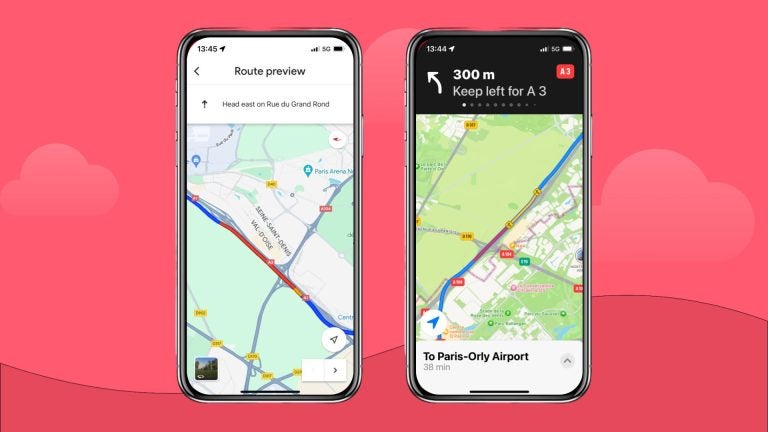
8. Availability
Availability is one area where Google Maps has a clear edge over Apple. That’s because Google Maps works on any mobile device, whether it’s an Android or iOS device. Apple Maps is only available to iPhone users, which simply means it’s not as widely available as its competition.
Apple Maps are also available on other iOS and macOS devices, but let’s be honest here, you’re probably using your cell phone for navigation apps.
Winner: Google Maps
Thankfully, availability isn’t an issue with Holafly, with eSIMs working on most modern Android phones and iPhones.
>Check out our complete eSIM-compatible phones list.<
Apple Maps vs. Google Maps: Which one should you choose?
Ultimately, Google Maps wins five categories out of eight, with one draw and two wins for Apple Maps. That said, most categories are very close, and if Apple Maps keeps improving at the same pace, we might see a different result soon enough.
Here’s a quick overview of how they compare in each category.
| Category | Result |
| Navigation | Winner: Google Maps Google Maps edges out Apple Maps slightly thanks to the ability to set up a trip with multiple stops. |
| Interface | Winner: Apple Maps Apple has a simpler, more intuitive interface, while Google Maps has features and buttons scattered throughout the screen. |
| Privacy | Winner: Apple Maps Apple Maps offers fairly advanced privacy features for its users. Meanwhile, Google Maps doesn’t do anything to enhance privacy. Instead, it collects user data for targeted ads and personalized searches. |
| Street view | Winner: Google Maps Both Google Street View and Apple Look Around features work similarly, but Google has a larger database, providing Street View in more locations worldwide. |
| Data usage | Winner: Draw Both Google Maps and Apple Maps use similar amounts of data. The exact numbers for how much data each app uses depend heavily on how you use the app. |
| Discovery | Winner: Google Maps Both apps allow you to find places to visit and things to do in any area, but Google Maps provides more information on each location and makes the search process quicker. |
| Traffic data | Winner: Google Maps Both provide real-time traffic information, which is partly collected from app users. Since Google has more users and collaborates with another map app, Waze, it has more traffic data and adjusts its routes slightly better. |
| Availability | Winner: Google Maps Apple Maps are only available to iOS and macOS users. Google Maps are available on all smartphones, making it more accessible to users. |
Apple Maps and Google Maps alternative: Waze
If you want to go against the grain and avoid using one of the two most popular navigation apps today, Waze is the best available alternative to Google Maps or Apple Maps. It doesn’t have advanced discovery features or street view, but it does a pretty good job of taking you to your destination.
Its user-friendly interface and very active community keep attracting new users to the app. It gets a lot of data from users reporting traffic jams, mobile speed cameras, and other things that may add some time to your trip. All in all, it’s a solid navigation app, albeit without all the bells and whistles offered by Google Maps and Apple Maps.
Final thoughts
As for now, Google still takes the cake when it comes to the overall user experience and accuracy. But Apple Maps is not far behind and may be a better option if you prioritize privacy and a simple interface.
With the two being so closely matched, both Apple Apps and Google Maps continue trying to grow and improve to avoid giving up their spot to the competitor. In the end, the true winners here are all of us, the users, because we get to enjoy an ever-improving experience when using either map app.
FAQs
Apple has a more intuitive user interface and better privacy features while offering a very similar navigation accuracy. However, Google offers more real-time traffic data, better street view coverage, and is available on both Android and iOS devices.
As it stands, Google Maps is still the most accurate map app. It receives the most users, so the app can gather more real-time traffic information than its competitors. Since Google also owns Waze, Google Maps also receives a boost from Waze’s vast database of routes and traffic information.
As far as navigation is concerned, both Google Maps and Apple Maps offer very similar experiences and accuracy. Google Maps might be slightly better for planning road trips because it allows you to add multiple stops to your trip, but both are equally as good for getting from point A to point B.





 Language
Language 


















 No results found
No results found














